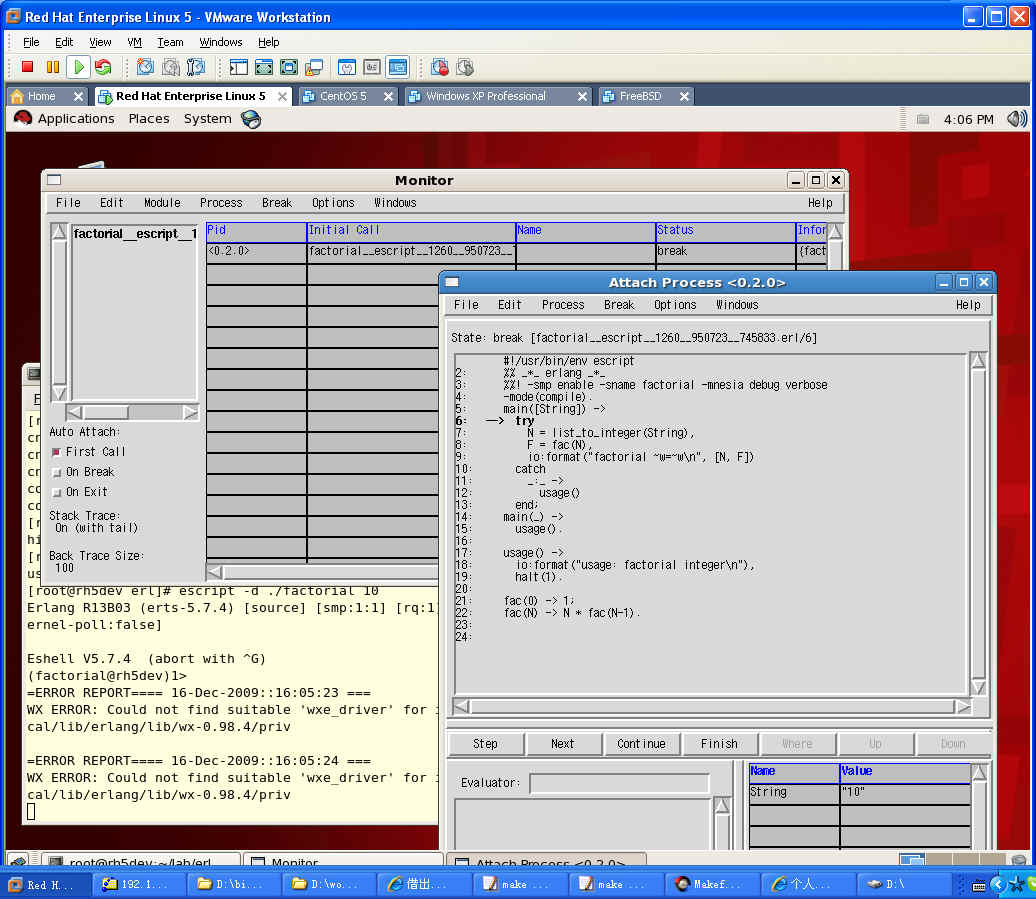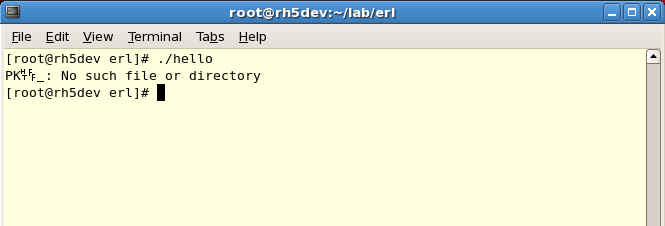今天从Mr. yufeng的blog上学了几招。先抄袭一下。^_^别拍我,我也为了查找方便嘛!
escript Erlang scripting support, 可以让erl模块转身变成unix script来使用,大大方便用户,具体的使用参看otp文档。我这里要演示的是些比较被忽视的高级特性:
首先crack erts/etc/common/escript.c:33 static int debug = 1; 让之显示调用参数。
root@nd-desktop:~# cat >factorial
#!/usr/bin/env escript
%% -*- erlang -*-
%%! -smp enable -sname factorial -mnesia debug verbose
main([String]) ->
try
N = list_to_integer(String),
F = fac(N),
io:format("factorial ~w = ~w/n", [N,F])
catch
_:_ ->
usage()
end;
main(_) ->
usage().
usage() ->
io:format("usage: factorial integer/n"),
halt(1).
fac(0) -> 1;
fac(N) -> N * fac(N-1).
CTRL+D
root@nd-desktop:~# chmod +x factorial
root@nd-desktop:~# ./factorial 10
erl +B -boot start_clean -noshell -smp enable -sname factorial -mnesia debug verbose -run escript start -extra ./factorial 10
factorial 10 = 3628800
特性1:
摘抄文档。。。
On the third line (or second line depending on the presence of the Emacs directive), it is possible to give arguments to the emulator, such as
%%! -smp enable -sname factorial -mnesia debug verbose
Such an argument line must start with %%! and the rest of the line will interpreted as arguments to the emulator.
我们可以看到 这些选项被传递给了 erl
特性2:
-mode(compile).
这个选项是在escript.erl这个模块处理的。默认情况下 escript是被解释执行的,如果你的脚本很复杂,那么效率估计会是瓶颈。这种情况下, 你可以通过这个选项来让escript来先编译你的模块成opcode, 在vm里面运行。
特性3:
-d 选项 用来调试script的
-c 编译执行
-i 解释执行
-s 只检查不执行
root@nd-desktop:~# escript -d ./factorial 10
我们就可以看到 调试界面如下图 
(这是我在自己的vm上实验的截图,那个GUI的debug画面是自己跳出来的,cool!)
特性4:
可以把一个beam文件作为script
root@nd-desktop:/usr/src# cat hello.erl
-module(hello).
-export([start/0,main/1]).
main(_)->
start().
start()->
io:format("hello world~n",[]).
root@nd-desktop:/usr/src# erlc hello.erl
root@nd-desktop:/usr/src# cat >hello
#!/usr/bin/env escript
%% -*- erlang -*-
%%! -smp enable -sname factorial -mnesia debug verbose
CTRL+D
root@nd-desktop:/usr/src# cat hello.beam >>hello
root@nd-desktop:/usr/src# chmod +x hello
root@nd-desktop:/usr/src# ./hello
hello world
特性5:
可以把一个zip文件作为script
root@nd-desktop:/usr/src# cat hello.erl
-module(hello).
-export([start/0,main/1]).
main(_)->
start().
start()->
io:format("hello world, fac(10)=~w ~n",[fac:fac(10)]).
root@nd-desktop:/usr/src# cat fac.erl
-module(fac).
-export([fac/1]).
fac(0) ->
1;
fac(N) -> N * fac(N-1).
root@nd-desktop:/usr/src# erlc *.erl
root@nd-desktop:/usr/src# erl
Erlang R13B03 (erts-5.7.4) [source] [smp:2:2] [rq:2] [async-threads:0] [hipe] [kernel-poll:false]
Eshell V5.7.4 (abort with ^G)
1> zip:zip("hello.zip", ["hello.beam", "fac.beam"]).
{ok,"hello.zip"}
2>
root@nd-desktop:/usr/src# cat >hello
#!/usr/bin/env escript
%% -*- erlang -*-
%%! -smp enable -sname factorial -mnesia debug verbose -escript main hello
CTRL+D
root@nd-desktop:/usr/src# cat hello.zip >>hello
root@nd-desktop:/usr/src# chmod +x hello
root@nd-desktop:/usr/src# ./hello
hello world, fac(10)=3628800
特性6:
在独立的包里面 把escript伪装成我们的应用程序
root@nd-desktop:/usr/src# cat >hello.escript
-module(hello).
-export([start/0,main/1]).
main(_)->
start().
start()->
io:format("hello world~n",[]).
CTRL+D
root@nd-desktop:/usr/src# cp `which escript` hello
root@nd-desktop:/usr/src# ./hello
hello world
规则是 escript 改名成xxxx 执行xxxx的时候 实际上要读取的脚本是 xxxx.escript
综述: escript是很强大的 未来的erlang standalone全靠它。
特性5,没有成功哇!下面截图。不知道,别人会不会遇上同样现象。
我现在调查原因。

另外,今天修改了nginx用来构建makefile的脚本。nginx的http, mail与其他我不感兴的代码,都被我去掉了。nginx的核心就是个用来开发高性能服务器的框架。http服务也好,mail服务也好都是有上面做的开发。但是这个是面向短连接的。





















 1111
1111

 被折叠的 条评论
为什么被折叠?
被折叠的 条评论
为什么被折叠?








